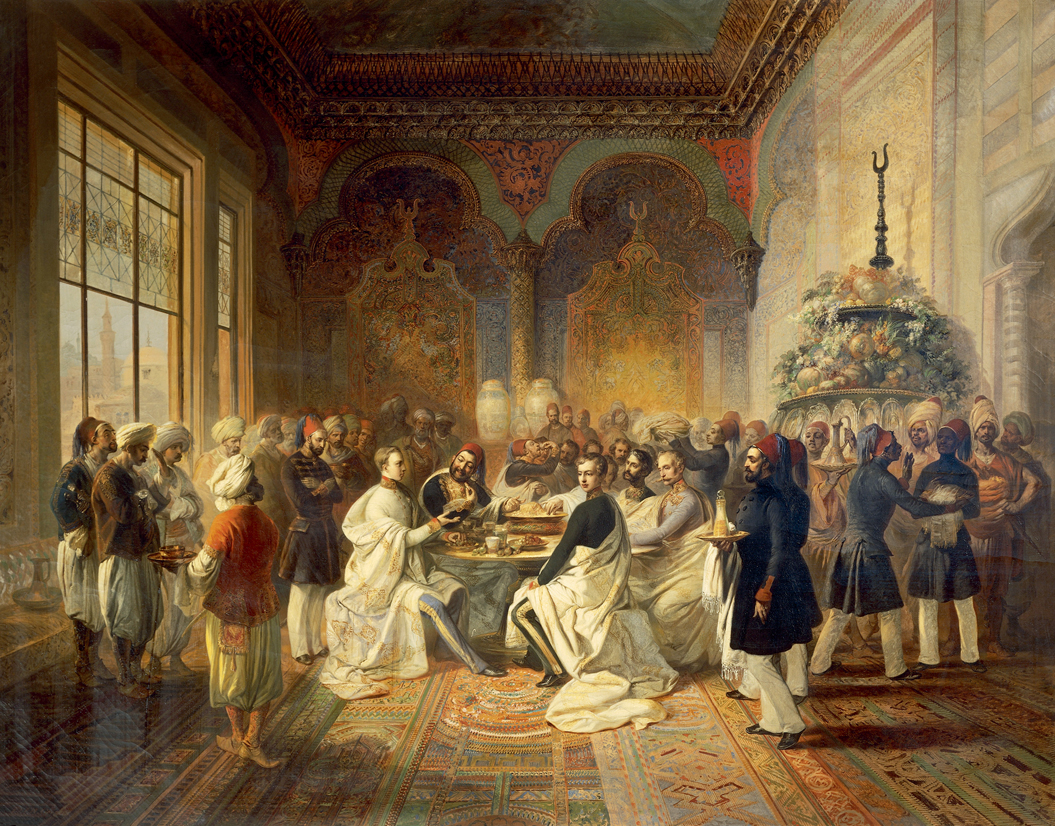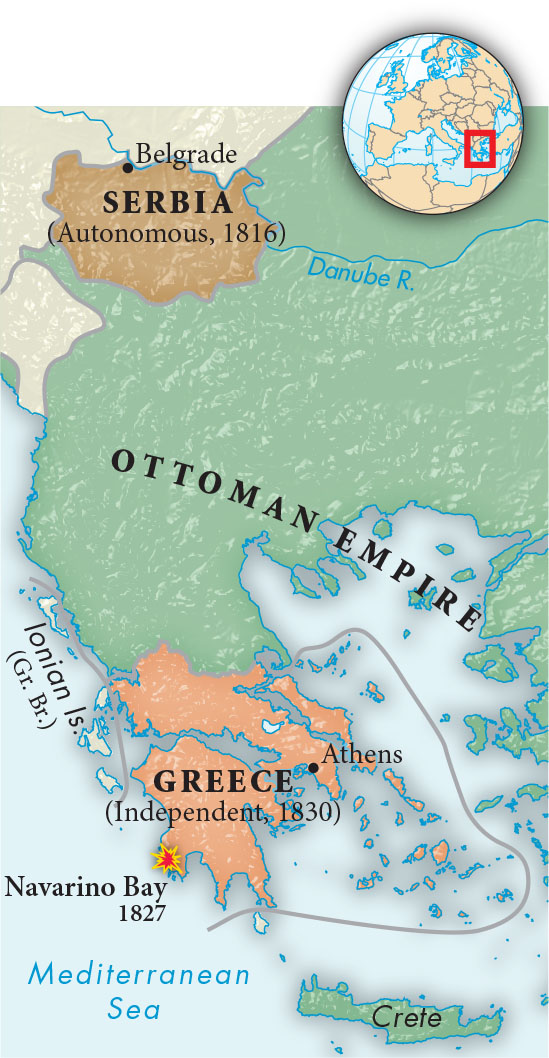A History of World Societies:
Printed Page 771
A History of World Societies Value
Edition: Printed Page 780
Chapter Chronology
Decline and Reform in the Ottoman Empire
Although the Ottoman Empire began a slow decline after Suleiman the Magnificent in the sixteenth century, the relationship between the Ottomans and the Europeans in about 1750 was still one of roughly equal strength. This parity began to change quickly and radically, however, in the later eighteenth century, as the Ottomans fell behind western Europe in science, industrial skill, and military technology.
A transformation of the army was absolutely necessary to battle the Europeans more effectively and enhance the sultanate’s authority within the empire. There were two primary obstacles to change, however. First, Ottoman military weakness reflected the decline of the sultan’s “slave army,” the so-called janissary corps (see “The Ottoman Empire’s Use of Slaves” in Chapter 17). With time, the janissaries — boys and other slaves raised in Turkey as Muslims, then trained to serve in the Ottoman infantry’s elite corps — became a corrupt and privileged hereditary caste. They zealously pursued their own interests and refused any military innovations that might undermine their high status. Second, the empire was no longer a centralized military state. Instead local governors were becoming increasingly independent, pursuing their own interests and even seeking to establish their own governments and hereditary dynasties.
The energetic sultan Selim III (r. 1789–1807) understood these realities, but when he tried to reorganize the army, the janissaries refused to use any “Christian” equipment. In 1807 they revolted and executed Selim in a palace revolution, one of many that plagued the Ottoman state. Selim’s successor, the reform-minded Mahmud II (r. 1808–1839), proceeded cautiously, picking loyal officers and building his dependable artillery corps. In 1826 his council ordered the janissaries to drill in the European manner. As expected, the janissaries revolted and charged the palace, where they were mowed down by the waiting artillery.

Pasha Halim Receiving Archduke Maximilian of Austria As this painting suggests, Ottoman leaders became well versed in European languages and culture. They also mastered the game of power politics, playing one European state against another and securing the Ottoman Empire’s survival. The black servants on the right may be slaves from the Sudan. (Painting by Peter Johann Nepomuk Geiger, 1850, oil on canvas/Miramare Palace, Trieste, Italy/De Agostini Picture Library/Gianni Dagli Orti/The Bridgeman Art Library)
The destruction and abolition of the janissaries cleared the way for building a new army, but it came too late to stop the rise of Muhammad Ali, the Ottoman governor in Egypt. In 1831 his French-trained forces occupied the Ottoman province of Syria and appeared ready to depose Mahmud II. The Ottoman sultan survived, but only by begging Britain, Russia, and Austria for help. They intervened and negotiated a peace settlement. The Ottomans were saved again in 1839, after their forces were routed trying to drive Muhammad Ali from Syria. In the last months of 1840 Russian diplomatic efforts, British and Austrian naval blockades, and threatened military action convinced Muhammad Ali to return Syria to the Ottomans. European powers preferred a weak and dependent Ottoman state to a strong and revitalized Muslim entity under a dynamic leader such as Muhammad Ali.
In 1839, realizing their precarious position, liberal Ottoman statesmen launched an era of radical reforms, which lasted with fits and starts until 1876 and culminated in a constitution and a short-lived parliament. Known as the Tanzimat (literally, “regulations” or “orders”), these reforms were designed to remake the empire on a western European model. The new decrees called for Muslim, Christian, and Jewish equality before the law and in business, security of life and property, and a modernized administration and military. New commercial laws allowed free importation of foreign goods, as British advisers demanded, and permitted foreign merchants to operate freely throughout an economically dependent empire. Under heavy British pressure, slavery in the empire was drastically curtailed, though not abolished completely. Of great significance, growing numbers among the elite and the upwardly mobile embraced Western education, adopted Western manners and artistic styles, and accepted secular values to some extent.
Intended to bring revolutionary modernization such as that experienced by Russia under Peter the Great (see “Peter the Great and Russia’s Turn to the West” in Chapter 18) and by Japan in the Meiji era (see “The Meiji Restoration” in Chapter 26), the Tanzimat achieved only partial success. The Ottoman state and society failed to regain its earlier power and authority for several reasons. First, implementation of the reforms required a new generation of well-trained and trustworthy officials, and that generation did not exist. Second, the liberal reforms failed to halt the growth of nationalism among Christian subjects in the Balkans (see below and Chapter 28), which resulted in crises and defeats that undermined all reform efforts. Third, the Ottoman initiatives did not curtail the appetite of Western imperialism, and European bankers gained a usurious stranglehold on Ottoman finances. In 1875 the Ottoman state had to declare partial bankruptcy and place its finances in the hands of European creditors.
Finally, the elaboration — at least on paper — of equal rights for citizens and religious communities failed to create greater unity within the state. Religious disputes increased, worsened by the Great Powers’ relentless interference. This development embittered relations between religious communities, distracted the government from its reform mission, and split Muslims into secularists and religious conservatives. Many conservative Muslims detested the religious reforms, which they considered an irreverent departure from Islamic tradition and holy law. These Islamic conservatives became the most dependable supporters of Sultan Abdülhamid II (r. 1876–1909), who abandoned the model of European liberalism in his long and repressive reign.

Ottoman Decline in the Balkans, 1818–1830
Meanwhile, the threat of Europe’s Great Powers gradually conquering the Ottoman Empire and dividing up its vast territories became quite real. At the beginning of the nineteenth century, while Ottoman forces were caught up in the Napoleonic Wars in Egypt, Serbian nationalists rebelled and forced the Ottomans to grant Serbia local autonomy in 1816. The Greeks revolted against Ottoman rule in 1821 and won their national independence in 1830. As the Ottomans dealt with these uprisings by their Christian subjects in Europe, they failed to defend their Islamic provinces in North Africa. In 1830 French armies began their long and bloody conquest of the Arabic-speaking province of Algeria. By 1860 two hundred thousand French, Italian, and Spanish colonists had settled among the Muslim majority, whose number had been reduced to about 2.5 million by the war against the French and related famines and epidemics.
Finally, during the Russo-Turkish War (1877–1878), absolutist Russia and a coalition of Balkan countries pushed southward into Ottoman lands and won a decisive victory. At the Congress of Berlin in 1878, the European Great Powers and the Ottoman Empire met to formally recognize Bulgarian, Romanian, Serbian, and Montenegrin independence. The Ottomans also gave up territory to the Russians in the Caucasus, Austria-Hungary occupied the Ottoman provinces of Bosnia-Herzegovina and Novi Pazar, and Great Britain took over Cyprus. The Ottoman Empire, now labeled the “sick man of Europe” in the European press, left the meeting significantly weakened and humiliated.
The combination of declining international power and conservative tyranny eventually led to a powerful resurgence of the modernizing impulse among idealistic Turkish exiles in Europe and young army officers in Istanbul. These fervent patriots, the so-called Young Turks, seized power in the 1908 revolution, overthrowing Sultan Abdülhamid II. They made his brother Mehmed V (r. 1909–1918) the figurehead sultan and forced him to implement reforms. Though they failed to stop the rising tide of anti-Ottoman nationalism in the Balkans, the Young Turks did help prepare the way for the birth of modern secular Turkey after the defeat and collapse of the Ottoman Empire in World War I (see “The Paris Peace Treaties” in Chapter 28).

